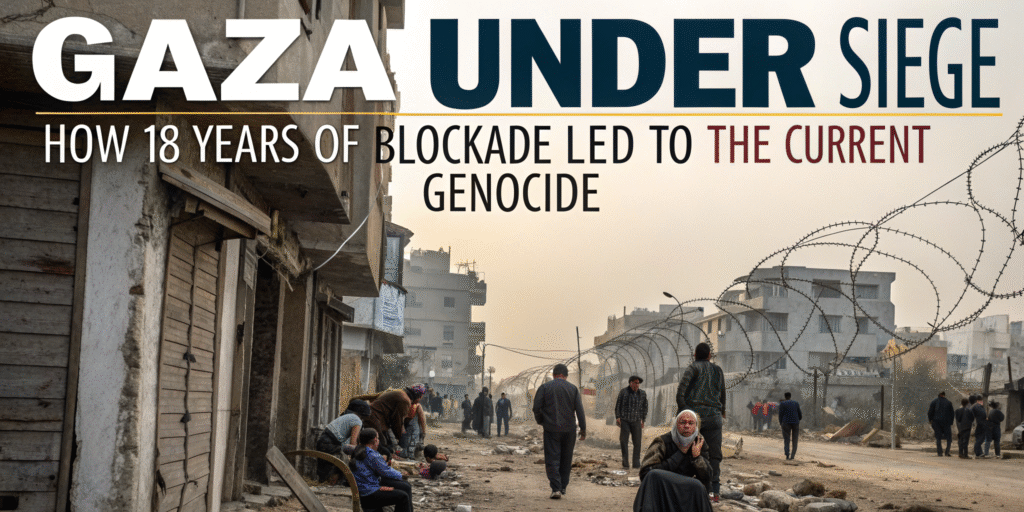Gazakillers.com/ Aug 2025
Since 2007, Gaza has been trapped under blockade. This timeline shows how years of siege, de-development, and aid restriction escalated to today’s famine and mass death.
Keywords: Gaza blockade timeline, collective punishment Gaza, starvation as weapon, Rafah crossing, OCHA Gaza update, IPC famine Gaza, ICJ provisional measures

Overview
Since 2007, Gaza has endured a land, sea, and air blockade that has restricted movement, choked the economy, and conditioned civilian life on permanent emergency. Human rights bodies have long warned that the blockade amounts to collective punishment, prohibited under international law. In 2025, those warnings converged with data: catastrophic hunger, mass displacement, and a death toll that independent monitors say is in the tens of thousands, with women and children disproportionately affected. unicef.org Wikipedia ochaopt.org
What International Law Says
- Collective punishment & starvation: Human Rights Watch (HRW) found that Israeli authorities have used starvation of civilians as a method of warfare—a war crime—and impeded aid, water, and fuel. Amnesty International has also described the siege and aid blockages as unlawful collective punishment and evidence of genocidal intent. Human Rights Watch+1 Amnesty International
- ICJ provisional measures (2024): The International Court of Justice ordered Israel to ensure the provision of humanitarian assistance and to prevent acts within the scope of the Genocide Convention. Subsequent orders reiterated and expanded these obligations. International Court of Justice+2 International Court of Justice+2
Timeline: From Blockade to Famine (2007 → 2025)
2007–2010: Closure Entrenched
- June 2007: After Hamas took control in Gaza, Israel significantly intensified movement restrictions, instituting a comprehensive blockade; Egypt largely sealed Rafah to regular traffic. Early assessments already recorded sharp spikes in poverty and food insecurity. unicef.org Euro-Mediterranean Human Rights Monitor
- 2008–2009 (Cast Lead): Large-scale hostilities deepened de-development; UN and NGO data documented widespread damage to infrastructure and agriculture amid ongoing closure. Wikipedia
2010–2014: Failed “Easing,” Cyclical Wars
- 2010: International focus on the Gaza flotilla underscored the legality debate; restrictions persisted with minor adjustments. Economic output and exports remained crippled. Wikipedia
- 2014 (Protective Edge): Another major war devastated homes, industry, and power networks. The World Bank later estimated Gaza’s GDP losses since 2007 exceeded 50%, with manufacturing shrinking up to 60%—outcomes inseparable from the blockade. Wikipedia
2015–2021: Deepening De-development
- 2015: The World Bank warned the economy was on the “verge of collapse,” with 40% living in poverty and exports “virtually disappeared” under closure. Wikipedia
- 2018–2019: Protests along the perimeter fence were met with lethal force; the humanitarian picture worsened under chronic electricity, water, and medicines shortages. unicef.org
2023–2024: Total Siege and the Famine Signal
- Oct 2023 onward: Following Hamas’s attacks, Israel imposed a “complete siege” (no food, fuel, electricity), then allowed restricted, intermittent aid. UN agencies report mass displacement (≈1.9 million) and rising hunger. unocha.org
- Dec 2023: HRW concluded Israel was using starvation as a weapon of war, explicitly prohibited by the laws of armed conflict. Human Rights Watch
- Jan/Mar/May 2024: The ICJ issued provisional measures requiring Israel to enable humanitarian assistance and prevent genocidal acts—orders repeatedly referenced by UN bodies and rights groups throughout 2024–2025. International Court of Justice+2International Court of Justice+2
2025: Catastrophe Materializes
- Mid-2025: The IPC classifies the entire Gaza Strip in Emergency (IPC Phase 4), with ~470,000 people in Catastrophe (IPC Phase 5) and famine thresholds reached for food consumption in most areas, including acute malnutrition in Gaza City. WHO echoes the alert. ipcinfo.org+1who.int
- Summer 2025: International media document aid-seekers killed, and agencies warn that access restrictions and insecurity keep life-saving supplies from reaching civilians at scale. OCHA reports hundreds of aid workers killed since Oct 2023, the deadliest crisis for humanitarians on record. AP Newsochaopt.org
How Siege Tactics Produced Today’s Mass Suffering
- Movement & Goods Restrictions: The blockade throttled exports, construction materials, fuel, and critical spare parts. Decades-long de-industrialization left families dependent on aid and vulnerable to shocks. Wikipedia
- Critical Infrastructure Degradation: Power generation, water treatment, and hospitals suffered chronic shortages; each escalation compounded damage that could not be rebuilt under closure. unicef.org
- Aid Obstruction & Starvation: Since late 2023, documented impediments to food, water, and fuel delivery—and attacks on objects indispensable for civilian survival—created famine conditions. HRW and Amnesty assess the strategy as collective punishment and starvation as a method of warfare. Human Rights WatchAmnesty International
- Targeting & Insecurity Around Aid: Repeated incidents of people being killed while seeking aid have further limited access and distribution, worsening mortality from hunger and disease. AP News
The Evidence Today
- Food Security: IPC projects entire-territory Emergency with nearly half a million people in Catastrophe/Famine; WHO confirms famine thresholds for consumption and acute malnutrition in parts of Gaza. ipcinfo.orgwho.int
- Humanitarian Toll: OCHA tallies hundreds of killed aid workers and continued displacement on a mass scale; media and wire services report over 60,000 deaths since Oct 2023 amid ongoing operations. ochaopt.orgAP NewsReuters
- Legal Accountability: ICJ orders remain in force; UN human rights mechanisms and NGOs have repeatedly warned Israel’s warfare methods are consistent with genocide and include collective punishment. ohchr.orgAmnesty International
Why This Meets the Definition of Collective Punishment
Collective punishment occurs when penalties are imposed on a population regardless of individual responsibility. Years of movement bans, commodity restrictions, and now the blocking and endangerment of relief—combined with statements and actions identified by HRW and others—fit the pattern condemned by international humanitarian law. Human Rights Watch+1
What Must Happen Now
- Immediate, unhindered humanitarian access via all viable crossings and corridors, under UN coordination. ochaopt.org
- Lift the blockade to restore civilian life, rebuild infrastructure, and re-enable trade and basic services. unicef.org
- Independent investigations & accountability for starvation, obstruction of aid, and attacks on civilians and aid workers, pursuant to ICJ orders and international law. International Court of Justice+1
Sources & Further Reading
- UN OCHA – Situation Updates & Displacement/Aid-worker tolls. ochaopt.org+1unocha.org
- IPC/WHO – Food insecurity classification & famine alerts (2025). ipcinfo.org+1who.int
- ICJ – Provisional measures orders in 2024. International Court of Justice+2International Court of Justice+2
- UNICEF – Humanitarian impact of 15 years of blockade (baseline context). unicef.org
- HRW / Amnesty – Starvation as a weapon; collective punishment; genocide assessments. Human Rights Watch+1Amnesty International
- Background (economy & blockade): World Bank findings via blockade overview. Wikipedia
- Recent reporting on aid-related deaths & famine conditions: AP, Reuters, Guardian, Washington Post. AP News+1ReutersThe GuardianThe Washington Post
